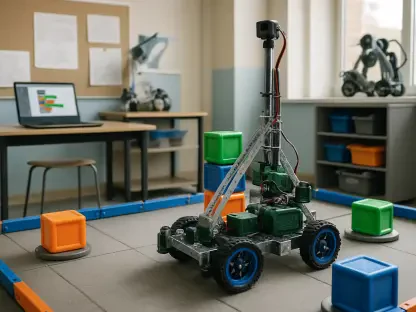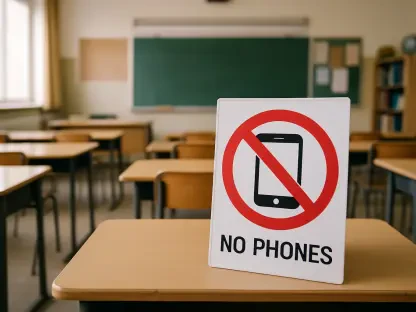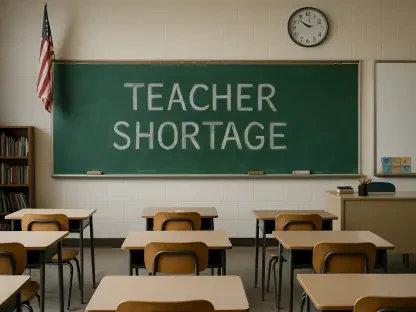As temperatures soar across the United States due to the relentless progression of climate change, a particularly vulnerable group—children—faces unprecedented risks that could shape their lives for decades to come. Extreme heat is no longer just a seasonal inconvenience; it has evolved into a public health and educational crisis with far-reaching consequences. Young bodies, still in development, struggle to cope with rising temperatures, while their dependence on adults for protection often leaves them exposed to harm. Beyond the immediate physical dangers, the impact ripples outward, disrupting mental well-being, hindering academic progress, and threatening long-term economic stability. This issue demands attention not only for its urgency but also for the profound inequities it reveals, as children in under-resourced communities bear a disproportionate burden. The challenges extend to schools and childcare facilities, many of which are ill-equipped to handle heatwaves, leaving families and educators grappling with impossible choices. Delving into this crisis reveals the critical need for systemic change to safeguard the next generation.
Unpacking the Dangers of Rising Temperatures
Why Young Bodies Are at Greater Risk
Children face unique physiological challenges when confronted with extreme heat, making them far more susceptible to its harmful effects than adults, as their bodies take longer to adjust to high temperatures. They also lose fluids more rapidly, increasing the likelihood of dehydration and heat-related illnesses like heatstroke. Additionally, their inability to effectively self-regulate body temperature, coupled with a tendency to engage in active outdoor play, heightens exposure to dangerous conditions. Often, adults may not recognize the subtle signs of heat stress in children, delaying critical intervention. This vulnerability is particularly alarming given the spike in emergency room visits during heatwaves, especially among economically disadvantaged families who may lack access to adequate cooling or healthcare. The health consequences are not just immediate; they can exacerbate chronic conditions such as asthma, burdening families with rising medical costs and impacting overall quality of life for years.
The long-term health implications of heat exposure in childhood cannot be understated, as they often lay the groundwork for persistent challenges into adulthood. Repeated or severe heat-related incidents can weaken immune responses and worsen respiratory issues, creating a cycle of vulnerability that is hard to break. For children living in poverty—roughly 16% of the population—these risks are magnified due to limited access to safe environments during extreme weather. Poor housing conditions, such as a lack of air conditioning or proper ventilation, compound the problem, turning homes into potential heat traps. Furthermore, the stress of coping with these conditions can take a psychological toll, contributing to anxiety and other mental health concerns. Addressing these physiological risks requires more than temporary fixes; it calls for a deeper understanding of how heat uniquely impacts young bodies and a commitment to protecting those least equipped to withstand it.
Compounding Chronic Health Challenges
Extreme heat does more than cause acute illnesses; it aggravates pre-existing medical conditions in children, creating a cascade of health challenges that can be difficult to manage. For those with asthma or eczema, high temperatures can trigger flare-ups, making breathing harder or skin conditions more painful and prone to infection. Humidity, often accompanying heatwaves, only worsens these issues, leaving children in discomfort and unable to participate fully in daily activities. Medical data highlights a troubling trend of increased hospital admissions during periods of intense heat, particularly in communities with limited healthcare access. Families then face not only the emotional strain of managing chronic illnesses under such conditions but also the financial burden of frequent medical interventions, which can be crippling for those already struggling economically.
Beyond the physical exacerbation of conditions, the broader implications for children’s development are significant and often overlooked, as constant health setbacks due to heat can disrupt regular routines. This disruption prevents consistent school attendance and limits opportunities for physical activity, both of which are critical for growth. The psychological impact of living with worsened chronic conditions also plays a role, as children may feel isolated or frustrated by their limitations during heatwaves. This is especially true in underfunded areas where schools and community centers lack the resources to provide relief or adaptive programs. The intersection of environmental stressors and health disparities reveals a stark reality: without targeted interventions, the cycle of poor health outcomes will persist, undermining the potential of countless young individuals. Addressing this requires a multifaceted approach that prioritizes both medical support and environmental improvements to shield children from heat’s compounding effects.
Educational and Economic Fallout from Heat Exposure
Disruption of Learning Environments
Extreme heat profoundly disrupts children’s ability to learn, creating barriers that extend far beyond the classroom walls. High temperatures impair concentration, making it difficult for students to focus on lessons, while also increasing irritability and aggression among peers, which can derail classroom dynamics. Sleep disruption is another critical factor, as uncomfortably warm nights prevent restful recovery, leaving children fatigued and less prepared for academic challenges. Research indicates that for every 1°F increase in average annual temperature in schools without adequate cooling systems, learning outcomes drop by 1%. This statistic paints a grim picture of how environmental conditions directly undermine education, particularly in districts unable to afford modern infrastructure, setting students on a path of cumulative disadvantage that is hard to overcome.
The ripple effects of heat on learning are not confined to immediate academic performance but extend to long-term educational attainment, creating significant challenges for students. When schools lack proper ventilation or air conditioning, students are forced to endure conditions that sap their energy and hinder retention of information, leading to gaps in knowledge that widen over time. These challenges are compounded in low-income areas where resources for tutoring or summer programs to make up for lost learning are scarce. Additionally, the behavioral issues spurred by heat stress can lead to disciplinary actions, further disrupting a child’s educational journey. The economic implications loom large as well, with projections estimating potential income losses of nearly $7 billion annually if current warming trends persist without intervention. This stark reality emphasizes that protecting learning environments from heat is not just an educational priority but a societal imperative with lasting consequences.
Long-Term Economic Consequences
The economic fallout from heat-related disruptions in childhood education casts a long shadow over future prosperity, as students face consistent barriers to learning due to high temperatures. When education is impaired by such conditions, students are less likely to achieve the academic milestones necessary for higher education or skilled employment, limiting their earning potential. The cumulative effect of even small annual declines in learning—tied directly to inadequate school cooling—translates into billions in lost income over a generation. This burden falls heaviest on communities already grappling with economic hardship, where families cannot afford private solutions like home cooling or supplementary education, perpetuating cycles of poverty and inequality that are increasingly difficult to escape in a warming world.
Moreover, the economic impact extends beyond individual earnings to broader societal costs that strain public resources. Reduced educational attainment often correlates with higher rates of unemployment or underemployment, increasing reliance on social services and healthcare systems already stretched thin. Businesses also suffer from a less skilled workforce, hampering productivity and innovation at a national level. The financial stress on families during heatwaves—such as lost wages from parents missing work to care for children during school closures—adds another layer of economic pressure. Without strategic investments to mitigate the impact of heat on education, the long-term costs will continue to mount, affecting not just individual futures but the economic stability of entire communities. Addressing this crisis now is essential to prevent a future where heat exposure dictates economic outcomes.
Struggles of Educational Institutions in Heatwaves
Navigating Impossible Operational Choices
Schools and childcare facilities grapple with excruciating decisions during extreme heat events, often caught between equally harmful options, as they strive to balance safety and continuity. Keeping facilities open in sweltering conditions poses direct risks to children’s health, especially in the 41% of U.S. schools with outdated or insufficient HVAC systems. Indoor temperatures can become unbearable, while outdoor areas like unshaded playgrounds turn into hazards with surfaces hot enough to cause burns. The lack of funding for infrastructure upgrades in many districts, particularly those serving low-income populations, exacerbates the danger, leaving educators with no safe way to maintain normal operations. This reality forces a reckoning with the immediate safety of students versus the broader consequences of disrupting their routines.
On the flip side, closing schools during heatwaves introduces a host of other challenges that ripple through families and communities, affecting their daily lives and stability. Learning loss is a primary concern, as missed days accumulate and hinder academic progress, particularly for students without access to alternative educational resources. School closures also disrupt access to critical services like meals, which many children rely on for daily nutrition. For working parents, especially those without flexible schedules or the means to arrange emergency childcare, closures can lead to missed wages and heightened financial stress. The strain is most acute in households lacking cooling at home, where children face the same oppressive heat with no respite. These operational dilemmas highlight a systemic failure to prepare educational institutions for climate-driven challenges, underscoring the urgent need for solutions that prioritize both safety and continuity.
Infrastructure Deficits in Underfunded Areas
The state of school infrastructure in many parts of the country reveals a glaring inability to cope with rising temperatures, particularly in underfunded districts. Aging buildings with poor insulation or broken cooling systems turn classrooms into stifling environments that endanger health and impede learning. Outdoor spaces, often lacking shade or heat-resistant materials, become unusable during peak heat, depriving children of necessary physical activity. Budget constraints in low-income and rural areas mean that even basic upgrades—like installing air conditioning or repairing ventilation—are out of reach, leaving students and staff to endure conditions that would be unthinkable in better-resourced regions. This disparity in infrastructure readiness is a stark reminder of how systemic inequities amplify the risks of extreme heat.
Compounding the issue is the slow pace of addressing these infrastructure deficits, as funding often depends on local tax bases that are insufficient in struggling communities. Without external support, schools in these areas remain trapped in a cycle of deferred maintenance, where temporary fixes fail to address underlying problems. The lack of shaded green spaces or cool roofs, which could mitigate heat, further limits options for creating safer environments. Meanwhile, the health and academic toll on students mounts, with each heatwave serving as a painful reminder of the gap between need and resources. Federal and state intervention is critical to break this cycle, ensuring that infrastructure improvements are not a luxury but a baseline standard for protecting children. The longer these deficits persist, the greater the cost to both individual well-being and societal progress.
Addressing Inequities and Systemic Barriers
Disproportionate Burdens on Low-Income Families
Socioeconomic disparities play a pivotal role in magnifying the dangers of extreme heat for children, particularly in low-income households. Families in these communities often live in housing without air conditioning or adequate insulation, turning homes into oppressive environments during heatwaves. When schools close, children have nowhere to escape the heat, while parents face the added stress of arranging care or missing work, further straining tight budgets. Access to healthcare for heat-related illnesses is also limited, as medical costs can be prohibitive, leaving conditions untreated and worsening over time. This unequal burden creates a vicious cycle where economic hardship and environmental risks feed into each other, deepening existing inequalities.
The challenges extend beyond the home to the broader community infrastructure that low-income families rely on, which is often inadequate for coping with extreme weather, leaving many without essential support during critical times. Public cooling centers may be scarce or inaccessible, especially in rural areas where transportation is a barrier. Community resources like libraries or recreational facilities, which could provide relief, are frequently underfunded or closed during heat events due to staffing shortages. For children, this means fewer safe spaces to turn to, increasing their exposure to heat-related harm. The lack of systemic support in these areas highlights a critical gap in preparedness, where the most vulnerable are left with the fewest options. Addressing this disparity requires targeted policies that prioritize resources for those in greatest need, ensuring that economic status does not dictate a child’s safety during heatwaves.
Rural and Urban Divides in Resource Access
The divide between rural and urban communities adds another layer of complexity to the impact of extreme heat on children, as resource availability varies widely across these areas. In rural areas, schools and childcare centers often face isolation from emergency services and lack the funding for infrastructure upgrades like cooling systems. Long distances to medical facilities mean that heat-related illnesses can become life-threatening before help arrives. Additionally, rural families may depend on outdoor labor for income, leaving children unsupervised in hot conditions or exposed while accompanying parents. These unique challenges underscore how geographic isolation can exacerbate the risks of heat, leaving rural children particularly vulnerable to its effects.
Urban settings, while often better resourced, present their own set of barriers that hinder effective heat mitigation for children, especially in densely populated areas. The urban heat island effect, where concrete and asphalt trap heat, intensifies temperatures, making outdoor spaces like playgrounds dangerously hot. Many urban schools, especially in low-income neighborhoods, still lack adequate cooling despite higher budgets elsewhere in the city, reflecting intra-urban inequities. Overcrowded housing without ventilation further compounds the problem for families who cannot afford private cooling solutions. Both rural and urban contexts reveal a shared truth: without tailored interventions that address specific geographic and economic realities, children across all settings will continue to face disproportionate risks. Bridging these divides demands a nuanced approach that accounts for the distinct needs of each community.
Pathways to Protect Future Generations
Crafting Effective Policy Interventions
The escalating threat of extreme heat to children necessitates urgent policy interventions at the federal and state levels to ensure their safety and well-being. Congress must take the lead in establishing comprehensive guidelines and temperature standards for schools and childcare centers, providing clear benchmarks for safe operating conditions. Enhanced data collection on the impacts of heat events is also essential, as it would inform evidence-based strategies and highlight areas of greatest need. Beyond setting standards, policymakers should prioritize funding for critical infrastructure upgrades, such as modern HVAC systems and energy-efficient designs, to equip facilities with the tools to withstand rising temperatures. These steps are vital to create a framework that not only reacts to heatwaves but proactively prevents harm.
Equally important is the need for policies that address the root causes of vulnerability among children during extreme heat, ensuring that solutions are equitable and sustainable. Legislation should focus on providing grants or subsidies for low-income districts and rural areas, where the gap in resources is most pronounced, to prevent disparities from widening. Collaboration between government agencies, educational leaders, and health experts can foster innovative approaches, such as integrating heat resilience into school curricula to educate students on safety practices. Additionally, emergency response plans tailored to heat events must be mandated, ensuring schools and communities are prepared to act swiftly. By embedding these measures into national priorities, policymakers can lay the groundwork for systemic change that protects children across diverse environments, mitigating both immediate risks and long-term consequences.
Investing in Heat-Resilient Infrastructure
Looking back, the efforts to shield children from the dangers of extreme heat gained momentum when the scale of the crisis became undeniable, prompting a renewed focus on infrastructure investment. Retrofitting schools with updated cooling systems, cool roofs, and shaded outdoor areas emerged as a cornerstone of past initiatives, aimed at transforming educational spaces into safe havens during heatwaves. Significant funding was directed toward green spaces around childcare facilities, which helped lower ambient temperatures and provided natural cooling. These investments, often supported by federal grants, targeted under-resourced communities to ensure that infrastructure improvements reached those most in need, reflecting a commitment to equity that shaped early responses to the growing threat.
Reflecting on those strides, it’s clear that future progress hinges on scaling up these infrastructure solutions with even greater urgency and precision to address the growing challenges ahead. Past programs laid a foundation by prioritizing HVAC replacements and energy-efficient designs in schools, but expanding these efforts to cover all at-risk areas became the next logical step. Integrating technology, such as real-time temperature monitoring systems, offered a way to enhance safety protocols in facilities nationwide. Partnerships between local governments and the private sector also proved instrumental in past successes, suggesting a model for sustained investment. Moving forward, a renewed emphasis on building heat resilience through innovative and accessible infrastructure remains critical to safeguarding children’s health, education, and economic potential against the backdrop of a warming climate.









